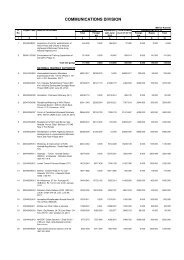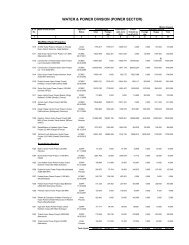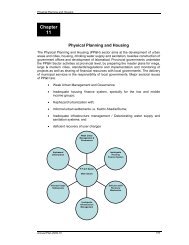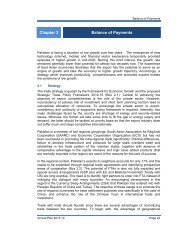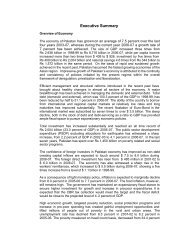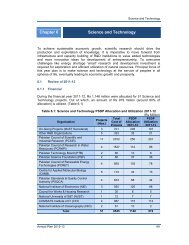Manual for Development Projects - Planning Commission
Manual for Development Projects - Planning Commission
Manual for Development Projects - Planning Commission
You also want an ePaper? Increase the reach of your titles
YUMPU automatically turns print PDFs into web optimized ePapers that Google loves.
Chapter 5<br />
Financial Analysis<br />
Financial analysis involves assessment of financial impact, judgement of efficient resource use,<br />
assessment of incentives, provision of a sound financing plan, coordination of financial contribution and<br />
assessment of financial management competence. The main objective of financial analysis is to<br />
determine the requirements of funds/timing and the expected returns on investment from the points of<br />
view of the various parties involved in the financing of the project. Under this analysis, judgement is<br />
framed about the project's financial efficiency, incentives, credit-worthiness and liquidity. In financial<br />
analysis, cost and benefits are calculated using current market prices. Interest payments on borrowed<br />
capital and repayment of loans are not included. Taxes in the <strong>for</strong>m of excise duties, customs duties, sales<br />
taxes are considered cost, while subsidies and loan receipts are considered benefits and are fully<br />
accounted <strong>for</strong> in the analysis.<br />
Economic Analysis<br />
Analysis from the economic aspect assesses the desirability of an investment proposal in terms of its<br />
effect on the economy. The question to be addressed here is whether the investment proposal contributes<br />
to the developmental objective of the country and whether this contribution is likely to be large enough<br />
to justify the use of scarce resources such as capital, skilled labour, managerial talents etc., that would<br />
be needed to implement and operate the project. In economic analysis, input and output prices are<br />
adjusted to reflect true social or economic values. These adjusted prices are often termed as shadow or<br />
accounting prices. The taxes and duties are treated as transfer payments and are excluded from the<br />
capital and operating cost. The two main steps in economic analysis are: (a) the "pricing of project<br />
inputs and outputs" and (b) the "identification of project costs and benefits". These steps are discussed<br />
below:<br />
(a) Pricing of Project Inputs and Outputs<br />
In economic analysis, the valuation of inputs and outputs can be made keeping in view the following three<br />
rules:<br />
i)<br />
ii)<br />
iii)<br />
Most of the inputs in economic analysis are valued at opportunity cost or on the principle<br />
of willingness to pay. Actually it is assumed that all inputs to the project are diverted away<br />
from alternative uses. Each input has generally value in alternative use. But this use may<br />
be sacrificed so that the input can be used by the project. This sacrifice is a cost to the<br />
nation; it is an opportunity <strong>for</strong>egone because of the project. Every input to the project is<br />
valued at this opportunity cost-the value of the input in its best alternative use;<br />
For some final goods and services, usually non-traded ones, the concept of opportunity<br />
cost is not applicable because it is consumption value that sets the economic value. This<br />
criterion is called "willingness to pay" or "value in use".<br />
The third rule of pricing inputs and outputs is that the analysis is done at present, i.e.<br />
constant prices. This is because current price analysis entails the prediction of inflation<br />
rate which is difficult and unreliable.<br />
(b) Identifying Project Costs and Benefits<br />
Page 4 of 24<br />
Proper identification of project costs and benefits is an important step. An improper identification of costs<br />
http://hd2/pc/popup/ch5_p.html<br />
9/23/2010




